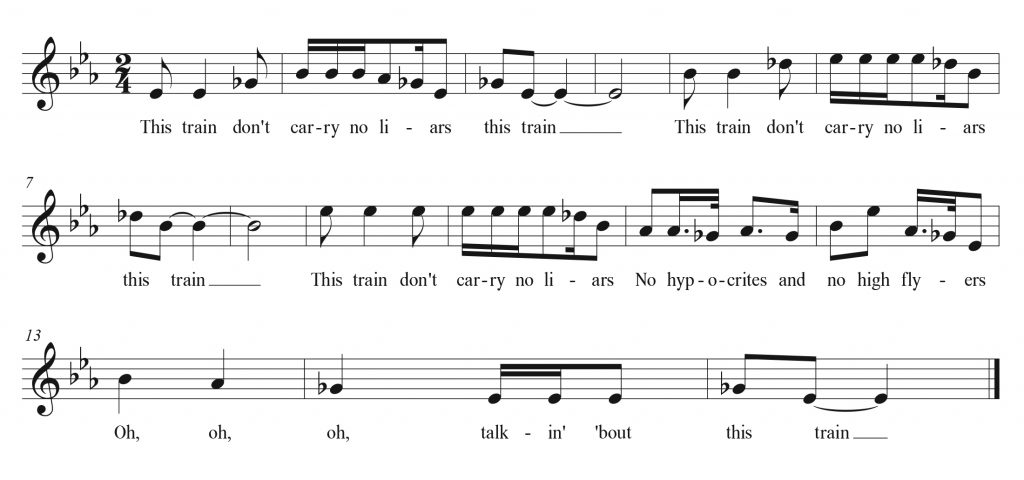Lesson 2: Exploring “This Train is Bound for Glory”
Aim: What musical opposites can we find in “This Train Is Bound for Glory”?
Summary: Students explore the meaning of the song, and learn musical opposites of dynamics (loud/soft) and tempo (fast/slow).
Materials: Music Explorers online audio
Standards: GA: ESGM2.CR.1, ESGM2.CR.2, ESGM2.PR.1, ESGM2.RE.1, ESGM3.RE.3, ESGM2.CN.1, ESGM2.CN.2
Vocabulary: dynamics, tempo, gospel
See Glossary →
Huxsie sings “This Train Is Bound for Glory” in a style of American music called gospel. Gospel music has diverse roots, but was influenced by African-American spirituals. Gospel music became popular in the 1930s, and can be differentiated from spirituals by the use of instruments such as drums, bass, and organ. Thomas A. Dorsey, known as the “Father of Gospel Music,” was the son of a Georgia Baptist preacher, but enjoyed composing and playing piano for blues and jazz music; he inserted those genres into his composing style for gospel music. Many popular artists began their musical journey singing gospel in the church, and went on to sing other genres of music, i.e., Aretha Franklin, Marvin Gaye, Beyoncé, and John Legend.
Sing “This Train is Bound for Glory”
- Listen to “This Train Is Bound For Glory”, Track 20.
Track 19– This Train Is Bound For Glory
Track 20 – This Train is Bound for Glory (Second Verse)
- Now listen to Huxsie’s friends sing the second verse of “This Train Is Bound for Glory,”
- Sing along with Huxsie’s friends. Please note that this excerpt is in a higher key, and students should sing along with this version to avoid vocal damage

This Train Is Bound For Glory
This train is bound for glory, this train,
This train is bound for glory, this train,
This train is bound for glory,
Don’t ride nothin’ but the righteous and holy
Oh, oh, oh, talkin’ ’bout this train.
This train don’t carry no liars, this train,
This train don’t carry no liars, this train,
This train don’t carry no liars, no hypocrites,
and no high flyers.
Oh, oh, oh, talkin’ ’bout this train.
This train has left the station, this train,
This train has left the station, this train,
This train has left the station, this train takes
on every nation.
Oh, oh, oh, talkin’ ’bout this train.
This train is built for speed, this train,
This train is built for speed, this train,
This train is built for speed, fastest train that
you ever did see,
Oh, oh, oh, talkin’ ’bout this train.
This train is bound for glory, this train,
This train is bound for glory, this train,
This train is bound for glory,
Don’t ride nothin’ but the righteous and holy
Oh, oh, oh, talkin’ ’bout this train.
Explore Musical Opposites in “This Train Is Bound for Glory”
- Explain that dynamics mean how loud or soft a song is.
- Explain that tempo means how fast or slow a song is. Ask your class which Musical Explorers songs are fast and which ones are slow.
- Listen for loud/soft dynamics and fast/slow tempos in “This Train Is Bound for Glory,” Track 19.
- Discuss the sounds that you hear a train make. Brainstorm some of the opposite sounds you might hear a train make.
What is a soft train sound? (e.g., the rumble of a distant train)
What is a loud train sound? (e.g., a train whistle or wheels screeching)
What is a slow train sound? (e.g., the sounds of the wheels starting)
What is a fast train sound? (e.g., the whoosh of the train whizzing by)
- Once you have decided on four contrasting train sounds, create a musical train. Divide the class into four groups and assign each group a train sound. Point to each group when you want them to start, gradually adding new sounds. Indicate when each group should stop making their sound. Remember to focus on musical opposites of loud/soft or fast/slow.
- Sing “This Train Is Bound for Glory,” adding in your own dynamic range and variations in tempo.
Explore Tempo Through Movement in “This Train Is Bound for Glory”
- Listen again to “This Train Is Bound for Glory,” Track 19.
- Instruct students to stand in a line and put their hands on the shoulders of the person standing in front of them, making a train.
- Explain to your students that the train will move with the steady beat of the song. Everyone in the train should listen carefully and walk to the steady beat.
Did the tempo stay the same? How did it change?
- Follow the tempo as it gets faster or slower, or even if the steady beat stops.
Creative Extension:
Explore Meaning in “This Train Is Bound for Glory”
- What does “glory” mean? Ask students to imagine a glorious place. (Common definitions of glory include great beauty and splendor; praise, honor, or distinction; a height of achievement).
- Turn to SG 21. Imagine that the train is headed for a glorious place and draw an image in the picture to represent this special place.
Musical Word Wall
Add the words dynamics, tempo, and gospel to the Musical Word Wall.
See Glossary →
PDF Downloads
↓ SG21 This Train is Bound for Glory
Audio Tracks
Track 19– This Train Is Bound For Glory
Track 20 – This Train is Bound for Glory (Second Verse)
